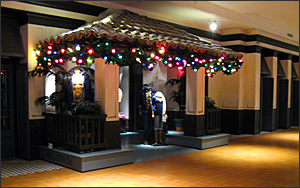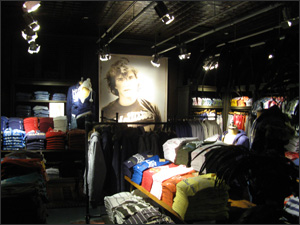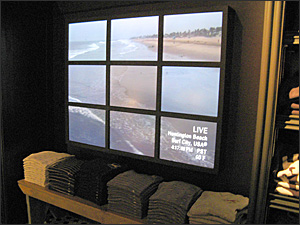 |
 | ||
|
part 1, 2
If you listen to a couple of 15-year-olds shopping, it doesn't exactly sound like brain science. Instead, it's mostly talk about what is and isn't cute. At least that's what Emily and her friends talk about when I hang out with them at the Mall of America. The Mall of America is the most visited shopping mall in the world. There are more than 500 stores here, not to mention the 14-screen movie theater, the largest indoor theme park in the United States, and in the basement, the world's largest underground aquarium. The place is huge. It's also a major site in the retail design world. It not only attracts shoppers from around the world, but since it's in Bloomington, Minnesota, it's packed with shoppers from "middle-America," a demographic incredibly important to national brands. Therefore, many retailers use the Mall of America as a retail lab, trying out new concepts, seeing if they'll fly, working out strategies. And as a designer living in Minneapolis, I have the rare opportunity to see firsthand the latest in retail design. I can only see the mall through the eyes of the designer, so occasionally it's interesting to look at it through the eyes of its target audience. Or one of its targets. Emily's small and thin with long, straight blond hair - pretty much what you'd imagine if you thought of a 15-year-old wholesome, Midwestern girl. And she loves the mall. She comes here almost every weekend. She knows what she likes and what she hates. We walk past Hot Topic, a T-shirt shop that caters to Goth kids. "I would never shop there!" she says with a laugh. "Never!" But what's interesting is which stores she likes and why. She says her favorite store is Hollister, a clothing store for teens. "It's very beachy-like. And when you go in, the music is pretty loud," Emily says. "It's actually kind of dark in there. There's just like a few lights on."
Hollister's different from most stores. From the outside, you can't see into the store at all. What you see instead sort of looks like a front porch of a cabana on the beach. There are deck chairs and surfboards. And a really strong bitter citrus smell. "You can always smell it when you're walking by. They spray perfume all the time," she explains. I ask her if she likes the smell. She laughs and says, "Yeah." She already wears the perfume. As you walk into Hollister, two things hit you immediately. First, it's very loud. The music is blaring. And second, it's very dark. "Yeah, it is actually pretty dark," Emily agrees, "but I think it's fine. I think the first time I was in here, I thought it was really different. I was like, 'I can't even see anything.' But you get used to it. They have lights on the clothes, so it's fine." So you'd think that this store is doing everything wrong - the music is so loud that you can't talk, it's so dark you can't see where you're going, the smell's so strong that you end up smelling it on your clothes for hours - you'd think this would only drive customers away. But not so. Hollister does about $1.4 billion in annual sales for its parent company Abercrombie and Fitch. And today, this store full of kids, all of whom look about Emily's age. "They're doing really well. It's amazing," says Joe Duffy, founder and chairman of Duffy & Partners, a design and branding firm in Minneapolis. In the design world, Duffy's is a pretty big name. His company has done high-profile branding work for Coca Cola, Starbucks, Aveda, and Jim Beam. He even branded the Bahamas. Yes, the country. I asked him to help me understand why Hollister appeals to Emily. "It's setting the mood, and it's about expressing the brand's personality," he says. "[It's] individualistic, having a good time, not just buying and selling, but creating the kind of ambiance that kids find appealing."
And that ambiance often has nothing to do with the actual product. In the middle of Hollister, there's this giant television screen. It's a webcam of surfers in California. It doesn't advertise specials. There's no Hollister logo or anything. Just surfers. "I think it puts people in the mood of saying, 'You know what? I love this experience, I love this idea. I love the mindset. I'm gonna buy something and make it a part of my life,'" says Duffy. A part of your life quite literally. Emily buys the clothes, she wears the perfume. And during our shopping trip, an interesting thing happens. The manager comes up to Emily and asks if she's finding everything. "Yes, thank you," Emily says politely. The manager asks, "You guys from around here?" "Yeah." "How old are you?" "I'm 15," Emily says hesitantly. The manager is disappointed. "Fifteen? Oh, OK. Let me know if you need anything else." As the manager walks away, her friend Evan laughs. "You were getting scouted!" In her sweatshirt and beach shorts, Emily looks so much the part of Hollister she could work here. At least the manager thinks so. But Emily's a little too young.
However, it is a revealing moment. Emily and Hollister have found each other. It's not just about cute clothes. It's about being part of a group, your tribe, the people who care about the things that you care about, who think about the things you think about. To solidify your place in the tribe, you buy a shirt that, in this case, says Hollister across the front. Creating the look and feel, creating that tribe - that's what branding is about. And we all have our tribes. If you're a Mac fan, you take a detour into the Apple store, because Apple gets it. They get that technology can be beautiful and easy to use. You subscribe to that belief, their belief. You buy into Apple's brand. Or maybe you like high-end cooking and entertaining. Williams-Sonoma draws you in with its gleaming copper pots and very subtle vanilla scent and seems to say, "Yes, we care about the things you care about." If you like furniture that's modern but affordable, you might drive across town to Ikea. And if you think Ikea gets it, you're much more likely to go out of your way to eat at the Ikea restaurant, or sport an Ikea backpack and become part of the Ikea tribe. Joe Duffy says this is actually a massive change in the marketing world. With commercial-free satellite and Internet radio stations, and television devices like TiVo that allow you to skip commercials, it's becoming easier and easier to ignore and even avoid ads, so advertisers have to speak to you in other ways: "Marketers today," says Duffy, "are putting a much larger percentage of their marketing dollars into the store environment where people can really feel the brand and don't look upon it as an interruption into their lives when they're watching a television show." And that rings true in my life. I mute the television during the commercials, and when I want to know which laundry detergent works the best, I just Google laundry detergent comparisons. But I am much more willing to check out brands that might fit with my outlook on life. For some, maybe it's a brand that has something to do with ecological responsibility, or maybe for others it's about patriotism, or for Emily, maybe it's about hanging out with friends, enjoying life, maybe being a little independent.
Continue to part 2 | ||




